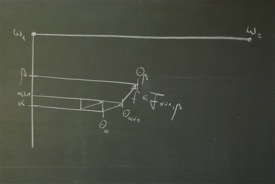

A simplified (κ,1)-morass is a structure M =<< θα | α ≤ κ >,< Fαβ | α < β ≤ κ >>
satisfying the following conditions:
(P0) (a) θ0 = 1, θκ = κ+, ∀α < κ 0 < θα < κ.
(b) Fαβ is a set of order-preserving functions f : θα → θβ.
(P1) |Fαβ| < κ for all α < β < κ.
(P2) If α < β < γ, then Fαγ = {f ∘ g | f  Fβγ,g
Fβγ,g  Fαβ}.
Fαβ}.
(P3) If α < κ, then Fα,α+1 = {id ↾ θα,fα} where fα is such that fα ↾ δ = id ↾ δ and
fα(δ) ≥ θα for some δ < θα.
(P4) If α ≤ κ is a limit ordinal, β1,β2 < α and f1  Fβ1α, f2
Fβ1α, f2  Fβ2α, then there are a
β1,β2 < γ < α, g
Fβ2α, then there are a
β1,β2 < γ < α, g  Fγα and h1
Fγα and h1  Fβ1γ, h2
Fβ1γ, h2  Fβ2γ such that f1 = g ∘ h1 and f2 = g ∘ h2.
Fβ2γ such that f1 = g ∘ h1 and f2 = g ∘ h2.
(P5) For all α > 0, θα = ⋃
{f[θβ] | β < α,f  Fβα}.
Fβα}.
Lemma
Let α < β < κ, τ1,τ2 < θα, f1,f2  Fαβ and f1(τ1) = f2(τ2). Then τ1 = τ2 and
f1 ↾ τ1 = f2 ↾ τ2.
Fαβ and f1(τ1) = f2(τ2). Then τ1 = τ2 and
f1 ↾ τ1 = f2 ↾ τ2.
A simplified morass defines a tree < T,≺>.
Let T = {< α,ν >| α ≤ κ,ν < θα}.
For t =< α,ν > T set α(t) = α and ν(t) = ν.
T set α(t) = α and ν(t) = ν.
Let < α,ν >≺< β,τ > iff α < β and f(ν) = τ for some f  Fαβ.
Fαβ.
If s ≺ t, then f ↾ (ν(s) + 1) is uniquely determined by the lemma. So we may define
πst := f ↾ (ν(s) + 1).
Lemma
The following hold:
(a) ≺ is a tree, htT (t) = α(t).
(b) If t0 ≺ t1 ≺ t2, then πt0t1 = πt1t2 ∘ πt0t1.
(c) Let s ≺ t and π = πst. If π(ν′) = τ′, s′ =< α(s),ν′ > and t′ =< α(t),τ′ >, then s′≺ t′ and
πs′t′ = π ↾ (ν′ + 1).
(d) Let γ ≤ κ, γ  Lim. Let t
Lim. Let t  Tγ. Then ν(t) + 1 = ⋃
{rng(πst) | s ≺ t}.
Tγ. Then ν(t) + 1 = ⋃
{rng(πst) | s ≺ t}.
 a, β
a, β  b, β < α}.
b, β < α}.
 aq ∀ξ
aq ∀ξ  (bp - bq) ∩ α p(α,ξ)≠p(β,ξ).
(bp - bq) ∩ α p(α,ξ)≠p(β,ξ).
 < π(γ),π(δ) >
< π(γ),π(δ) >
 < π(x),ε > .
< π(x),ε > .
 P | ap,bp ⊆ 1}.
P | ap,bp ⊆ 1}.
 P such that
P such that
 P(φα)
P(φα)
 P(φβ) | ap,bp ⊆ ν}.
Set σst : P(ν(s) + 1) → P(ν(t) + 1),p
P(φβ) | ap,bp ⊆ ν}.
Set σst : P(ν(s) + 1) → P(ν(t) + 1),p πst[p].
πst[p].
 Lim
Lim
 Tβ set P(ν(t) + 1) = ⋃
{σst[P(ν(s) + 1)] | s ≺ t} and P(λ) = ⋃
{P(η) | η < λ} for
λ
Tβ set P(ν(t) + 1) = ⋃
{σst[P(ν(s) + 1)] | s ≺ t} and P(λ) = ⋃
{P(η) | η < λ} for
λ  Lim where σst : P(ν(s) + 1) → P(ν(t) + 1),p
Lim where σst : P(ν(s) + 1) → P(ν(t) + 1),p πst[p].
πst[p].